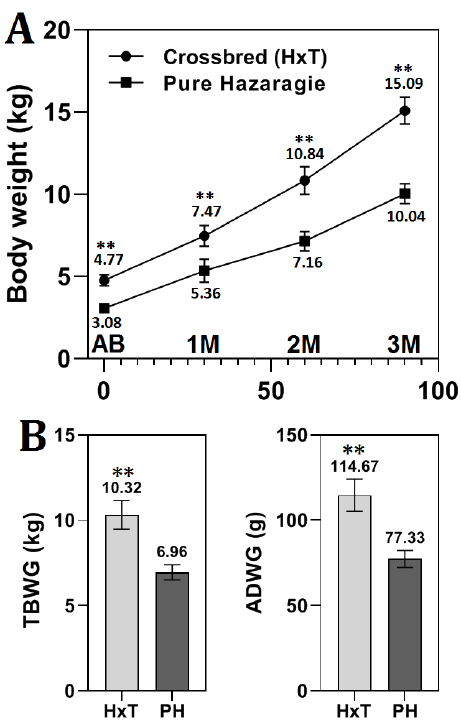Mohammad W. Hassani 1*
1, Department of Animal Sciences, Agriculture Faculty, Bamyan University, Bamyan, Afghanistan
E-mail:
mohammadwakil.hasani@gmail.com
Received: 05/08/2024
Acceptance: 26/08/2024
Available Online: 26/08/2024
Published: 01/01/2025

Manuscript link
http://dx.doi.org/10.30493/das.2024.471763
Abstract
This study investigates the effects of crossbreeding Hazaragie ewes with Turki rams on the growth of lambs in Bamyan Province, Afghanistan. A total of eighty Hazaragie ewes were separated into two groups: one group was mated with purebred Hazaragie rams, while the other group was mated with Turki rams. The growth performance of the lambs was observed for a duration of three months. The findings indicated that the crossbred lambs demonstrated superior growth parameters, such as elevated birth weight, overall body weight gain, and enhanced average daily weight gain. The genetic influence of the Turki breed is responsible for this, most likely due to positive heterosis, which is advantageous for meat production. Although the crossbred group had a lower rate of twins, the overall performance of the crossbred lambs exceeded that of the pure Hazaragie lambs collectively. According to the study, the process of crossbreeding has the potential to provide substantial economic advantages to sheep farmers in the region by enhancing the quantity and quality of meat produced. Further research is recommended to assess the long-term impacts of this specific crossbreeding on different production traits.
Keywords: Sheep breed, Hazaragie sheep, Turki sheep, Crossbreeding, Lamb weight gain, Twin rate
Introduction
Sheep farming is of a significant importance in Afghanistan agricultural sector and economy. It plays a critical role in the livelihood of many communities [1]. The optimum climatic conditions and the diverse and sometimes challenging terrains renders the country an ideal place for sheep farming. This industry provides essential products for local and international markets including dairy products, meat, and wool. Therefore, sheep production is a significant contributor in Afghanistan economy.
Climate change has undoubtedly influenced many production sectors including sheep production [2][3]. On the other hand, small ruminant production is contributing to climate change through greenhouse emissions [3]. Taking into consideration the significant increase in demand for sheep product and the expected increase in sheep numbers worldwide and in Afghanistan, it is crucial to focus on environmentally friendly methods of sheep production. These methods should increase livestock resistance to climate change and enhance their productivity without adverse effect on the environment.
One of the methods that is widely agreed upon to increase sheep production adaptability to climate change is cross breeding and, more specifically, developing thermotolerant breeds [4]. For that purpose, sheep breeds that is known to tolerate abnormally high or low temperatures should be used in husbandry programs to study their offspring adaptability and productivity.
One of the sheep breeds nominated for that purpose is Hazaragie sheep. Native to the mountainous Central Afghanistan, this breed is mainly kept by the Hazara people of the area, hence the name. Hazaragie is a small sized mutton type fat-tailed breed, well adapted to the cold environmental condition of region with temperatures reaching – 15° in winter and 26°C in summer with snowfall of 40 cm/year [5][6]. Hazaragie is primarily a meat breed with an average weight of 35 kg. Their wool is sheared twice a year and have a considerable milk production with a lactation period of about 138 days, and the average daily amount of milk is about 0.7 liters. The length of the pregnancy period is 5 months, and the annual rate of lambing is 98% with a twin birth rate of up to 42%. Despite its relatively modest meat, wool, and milk production volumes, framers are usually satisfied by the increased birth rates and resistance to rough environmental conditions in central Afghanistan. Therefore, only pure Hazaragie rams are used for breeding [7].
On the other hand, Turki sheep breed is one of the prominent meat breeds in Afghanistan. Originated in turkey but currently found in Iran and Afghanistan, this sheep breed is well known for its large size [8] and fast growth in addition to its resilience and adaptability. Compared to other sheep breeds in Afghanistan, this breed produces higher amounts of meat of better quality in addition to more milk [9] rendering it a valuable genetic material in husbandry programs.
Based on the previously mentioned points, this study investigates the breeding Turki rams with Hazaragie Ewes on the weight gain of lambs over a three-month period. By comparing the growth performance of lambs from this crossbreeding strategy to that of linebred Hazaragie lambs, the study aims to provide insights into the potential benefits and drawbacks of such breeding practices. The findings are expected to offer valuable information to sheep farmers and breeders seeking to enhance the productivity of their flocks under the ongoing economic and environmental changes.
Material and Methods
Study area
The study took place in Bamyan Province, Punjab, situated at a latitude of 34 degrees 31 minutes and 13 seconds north and a longitude of 68 degrees 8 minutes and 19 seconds east. The mean annual temperature is 24°C, while the average yearly precipitation amounts to 409.7 mm.
Animals
The animals belonged to a private livestock farm in the Panjab district of Bamyan province. 80 pure Hazaragie ewes (Fig. 1 A) with an average age of 3.5-4 years and average weight of 35±0.56 kg was selected and divided randomly into two groups. The first group (40 ewes) was set to breed with four pure Hazaragie rams (Fig. 1 B) with an average age of 4-4.5 years and average weight of 38±0.53 kg, while the second group (40 ewes) was set to breed with four pure Turki rams (Fig. 1 C) with an average age of 4-4.5 years and average weight of 57±0.54 kg. All animals were healthy and disease free.

Breeding and feeding
The breeding process commenced on 2 May 2018, and it spanned a duration of 30 days during which the rams successfully mated with the ewes. The animals grazed in open pasture during the breeding season and subsequently utilized the pasture during the period of pregnancy. Following the lambing process, the lambs consumed their mothers’ milk exclusively for the first month. Subsequently, they spent two months grazing in separate areas from their mothers, during which their diet was supplemented with pasture forage in addition to mothers’ milk. The Chi-square test at a significance level p<0.05 was used to compare the occurrence of twin births between two groups:

where Oi stands for observed value (actual value), and Ei stands for expected value.
Weight monitoring and statistical analysis
The newborn lambs were immediately weighed upon delivery and subsequently identified individually. They were then weighed again during the first, second, and third months. Body weight gain was calculated by subtracting initial weight from final weight (after 3 months). Average daily gain was calculated by dividing total weight gain by the experiment duration (90 days). The results of the studied groups of pure Hazaragie lambs (Fig. 1 D) and Hazaragie × Turki crossbreeds (Fig. 1 E) were compared using independent-samples T-test in SPSS 24.0 software.
Results and Discussion
Out of the first group of ewes (Hazaragie × Hazaragie), 40 fertilized Hazaragie ewes delivered 55 pure-breed Hazaragie lambs. Hence, the lambing rate in this group was 137.5%, with a twin rate of 37.5%. On the other hand, out of the second group of ewes (Hazaragie × Turki), a total of 44 crossbred lambs were born. Therefore, the lambing rate in this particular group was 110%, with a 10% twin rate. Using these results, a Chi-square test was conducted to compare the rate of twins between the two groups. The findings indicated a Chi-square value of χ2=8.34. Consequently, the rate of twins in the first group (Hazaragie × Hazaragie) is considerably greater than that of the second group (Hazaragie × Turki). The lower twin rate observed in the second group might be attributed to sire’s genetic influence on the rate of embryo survival [10] or incompatibility which could have affected the likelihood of a twin pregnancy in this group of ewes
Hazaragie × Turki crossbred lambs demonstrated a significantly higher birth weight (4.77 kg) compared to pure Hazaragie lambs (3.08 kg) (Fig. 2 A). This observation suggests that the Turki rams’ genes have significantly contributed to lambs’ weight at birth. This characteristic is highly influential in sheep breeding, since lambs with higher birth weight usually perform better and have an enhanced meat nutritional indexes than those with lower birth weight [11].

Crossbred lambs continued to significantly outperform the pure Hazaragie lambs in terms of total bodyweight throughout the experiment period and at each weighting observation point (first month, second months, and third months). This superiority appears to increase during the last two months as the difference in total bodyweight between the crossbred lambs and pure Hazaragie lambs reached 3.68 kg after two months and 5.05 kg after three months with crossbred lambs reaching a total bodyweight of 15.09 kg (Fig. 2 A). Therefore, a superior total body weight increase of 10.32 kg was observed in crossbred lambs compared to the 6.96 kg increase in Hazaragie lambs. The significant weight difference throughout the monitoring period highlights the enhanced growth potential of Hazaragie × Turki crossbred lambs, which is mostly attributed to positive heterosis [12]. These findings are in agreement with previous reports indicating that using sires from larger sheep breeds can improve lamb performance and growth at weaning [13]. What makes the current results highly interesting is the rapid increase in lambs’ weight after the first month (the age they started grazing in pasture) and until the end of the third month (Approximately weaning age), probably referring to a higher conversion ratio in crossbred lambs compared to pure Hazaragie. This rapid increase in weight compared to pure Hazaragie could be more interesting if compared in later studies with pure Turki lambs for a prolonged duration. Since both breeds are considered local and hardy to the environmental conditions, any increase in meat production quality and quantity through crossbreeding would be appreciated by sheep farmers in the area.
The crossbred lambs (Hazaragie × Turki) exhibited superior performance compared to the pure Hazaragie lambs in terms of total body weight gain. At the end of the 3-month period, the crossbred lambs gained 10.32kg, while the pure Hazaragie lambs gained 6.96kg. Similarly, the crossbred lambs had an average daily weight gain of 114.67g, whereas the pure Hazaragie lambs had an average daily weight gain of 77.33g. These differences in weight gain were statistically significant (Fig. 2 B).
The primary factor contributing to the ongoing inbreeding of Hazaragie sheep in the area is the notable occurrence of twin births in this breed, which is widely regarded as a favorable characteristic. The latest study revealed that the rate of twin births in pure Hazaragie × Hazaragie is 37.5%, which closely aligns with the previously documented rate of 42% [7]. Although the ratio of twin births in the crossbreed of Hazaragie and Turki was significantly lower (10%), the total final body weight of all the crossbred lambs (44 lambs) after 3 months was 663.96 kg, which is considerably greater than the total final body weight of all the pure Hazaragie lambs (55 lambs), which was 552.2 kg. Highlighting this aspect could persuade sheep farmers to choose crossbreeding over inbreeding, as it ultimately leads to higher weight gain. This is particularly true if the ongoing monitoring of Hazaragie × Turki crossbreed continues to demonstrate its superiority in terms of meat quality, milk and wool production, and feed conversion ratio. Such evidence will confirm the economic benefits of this particular crossbreed.
Study Limitations
While the results of this study are significant and can offer practical guidance to sheep farmers, particularly those raising Hazaragie sheep, it is important to acknowledge certain limitations that should be addressed in future research:
- The Turki pure lambs were not subjected to a comparative analysis under identical conditions in order to assess their performance in comparison to the Hazaragie × Turki crossbred lambs. Such a comparison would provide additional information of the genetic material inheritance from both sheep breeds.
- An increase in the number of animals is recommended in the following works.
- It is essential to monitor the crossbred sheep for an extended period to further track the survivability and performance (quantity and quality of meat, milk, and wool production) of the crossbreed.
Conclusion
The study reveals that crossbreeding Hazaragie ewes with Turki rams can significantly improve lamb growth performance. The crossbred lambs outperformed the purebred Hazaragie lambs in terms of birth weight, total body weight gain, and average daily weight gain. This suggests a strong influence of Turki genetics, likely due to positive heterosis, which is beneficial for meat production. The lower twin rate in the crossbred group did not offset the overall enhanced performance of the crossbred lambs, which achieved a higher final total body weight compared to the pure Hazaragie lambs. This highlights the potential economic benefits of crossbreeding, leading to greater meat yield and potentially improved meat quality, which are critical factors for sheep farmers in the region. Future research should explore the long-term impacts of crossbreeding on other important traits, such as meat quality, milk production, wool yield, and feed conversion efficiency, to provide comprehensive guidance to sheep farmers.
References
- Azimi A, Anwari S, Keyhani A. Sheep Production Systems and Breeding Practices in Badghis Province. Indiana J. Agric. Life Sci. 2022;2(6):13-20.
- Sawyer G, Narayan EJ. A review on the influence of climate change on sheep reproduction. Comparative endocrinology of animals. In Comparative Endocrinology of Animals. Intechopen 2019;10. DOI
- Marino R, Atzori AS, D’Andrea M, Iovane G, Trabalza-Marinucci M, Rinaldi L. Climate change: Production performance, health issues, greenhouse gas emissions and mitigation strategies in sheep and goat farming. Small Rumin. Res. 2016;135:50-9. DOI
- Sejian V, Bhatta R, Gaughan J, Malik PK, Naqvi SM, Lal R. Adapting sheep production to climate change. In Sheep production adapting to climate change. 2017:1-29. DOI
- Blood PR. Afghanistan: A Country Study. Washington. GPO for the Library of Congress. 2001.
- Musavi SA, Ahmad S, Ibrahim M. Molecular characterization of Hazaragie sheep native to Central Afghanistan. Indian J. Anim. Sci. 2011;81(7):711-17.
- Musavi SA, Ahmad S, Ibrahim M. Documentation and morphology of Hazaragie sheep native to central Afghanistan. Indian J. Anim. Sci. 2013;83(9):934-41.
- Rahman A, Rehman S, Akhtar A, Jan I, Qureshi MS, Rahman S. Determination of meat yield and dressing percentage of Turki, Afghan Arabi and Baluchi sheep breeds in Afghanistan. Sarhad J. Agric. 2013;29(1):113-7.
- Rashiq, M. H. Sheep and goat husbandry. Kabul University, Kabu. 2005.
- Shorten PR, O’Connell AR, Demmers KJ, Edwards SJ, Cullen NG, Juengel JL. Effect of age, weight, and sire on embryo and fetal survival in sheep. J. Anim. Sci. 2013;91(10):4641-53. DOI
- Andrés S, Valdés C, Santos A, Mateo J, Giráldez FJ. Effects of birth weight on animal performance, fattening traits and meat quality of lambs. Animals. 2020;10(12):2364. DOI
- Cloete SW, Thutwa K, Scholtz AJ, Cloete JJ, Dzama K, Gilmour AR, Van Wyk JB. Breed effects and heterosis for weight traits and tick count in a cross between an indigenous fat-tailed and a commercial sheep breed. Trop. Anim. Health Prod. 2021;53. DOI
- Speijers MH, Carson AF, Dawson LE, Irwin D, Gordon AW. Effects of sire breed on ewe dystocia, lamb survival and weaned lamb output in hill sheep systems. Animal. 2010;4(3):486-96. DOI
Cite this article:
Hassani, M. Crossbreeding Hazaragie ewes with Turki rams and its effect on lamb growth and weight gain. DYSONA – Applied Science, 2025;6(1): 25-30. doi: 10.30493/das.2024.471763

